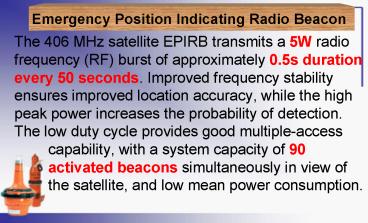Emergency Position Indicating Radio Beacon - PowerPoint PPT Presentation
1 / 20
Title:
Emergency Position Indicating Radio Beacon
Description:
Improved frequency stability ensures improved location accuracy, while the high ... The SART provides a visual or audible indication of its correct operation and ... – PowerPoint PPT presentation
Number of Views:215
Avg rating:3.0/5.0
Title: Emergency Position Indicating Radio Beacon
1
Emergency Position Indicating Radio Beacon
- The 406 MHz satellite EPIRB transmits a 5W radio
frequency (RF) burst of approximately 0.5s
duration every 50 seconds. Improved frequency
stability ensures improved location accuracy,
while the high peak power increases the
probability of detection. The low duty cycle
provides good multiple-access capability, with a
system capacity of 90 activated beacons
simultaneously in view of the satellite, and low
mean power consumption.
2
- An important feature of the new satellite EPIRB
is the inclusion of a digitally encoded message,
which may provide such information as the country
of origin of the unit in distress, identification
of the vessel or aircraft, nature of distress - and, in addition, for satellite EPIRBs
- code in accordance with the maritime
- location protocol, the ship's position as
determined by its navigation - equipment.
3
- Satellite EPIRBs are dual-frequency 121.5/406
MHz beacons. This enables suitably equipped SAR
units to home in on the 121.5 MHz transmission
and permits over flight monitoring by aircraft. - Depending on the type of
- beacon (maritime, airborne or land),
- beacons can be activated either
- manually or automatically.
4
System Performance and Operations Performance
parameters
- The following parameters are particularly
important for the user - EPIRB location probability
- EPIRB location error
- ambiguity resolution probability
- capacity
- coverage and
- notification time.
5
- EPIRB detection probability for the 406 MHz
satellite EPIRB is defined as the probability of
detection by LUT of at least one message with a
correct code-protected section from the first
tracked satellite.
6
2. EPIRB location probability for the 406 MHz
satellite EPIRB is defined as the probability of
detecting and decoding at least four individual
messages bursts during a single satellite pass so
that a Doppler curve-set estimate can be
generated by the LUT. At 121.5 MHz, EPIRB
location probability is defined as the
probability of location during a satellite pass
above 10 elevation with respect to the beacon.
EPIRB location probability relates to the two
solutions ("true" and "mirror") and not to
a single unambiguous result.
7
(No Transcript)
8
(No Transcript)
9
3. EPIRB location accuracy is defined as the
difference between the location calculated by the
system using measured Doppler frequencies and the
actual location.
10
(No Transcript)
11
4. Ambiguity resolution probability is defined as
the ability of the system to select the "true"
rather than the "mirror" location.
12
- Latitude and distance is determined
- Target could be on either orange dot
- We cant know which! (yet)
13
(No Transcript)
14
5. Capacity is defined as the number of EPIRBs in
common view of the spacecraft which the system
can process simultaneously.
15
6. Notification time is the period from
activation of an EPIRB spectral characteristic.
The values given below were confirmed by
statistical analysis of over 5,000 beacons during
the development and experiment phase.
121.5 MHz EPIRB - Average 6 Hour Notification 406
MHz EPIRB - Average 1 Hour Notification 406 EPIRB
with GPS - Average 5 minute Notification
16
(No Transcript)
17
Search and Rescue Radar Transponders (SARTs)
- Search and rescue radar transponders (SARTs) are
main means in the GMDSS for locating ships in
distress or their survival craft, and their
carriage on board ships is mandatory. The SART
operates in the 9GHz frequency band and generates
a series of response signals on being
interrogated by any ordinary 9GHz shipborne radar
or suitable airborne radar. No modification is
needed to a ship's radar equipment for detecting
SART signals. SARTs can be either portable, for
use on board ship or carrying into any survival
craft, installed on the ship and in each
survival craft, or so as to operate after
floating free from the sinking ship. They may
also be incorporated into a float- free satellite
EPIRB.
18
Operational and technical characteristics of SART
- 1. The SART can be activated manually or
automatically when placed into the water so that
it will thereafter respond when interrogated. - 2. When activated in a distress situation the
SART respond to radar interrogated by
transmitting a swept-frequency signal which
generates a line of blip code on a radar screen
outward from the SARTs position along its line
of bearing. This unique radar signal is easily
recognized on the radar screen and the rescue
vessel (and aircraft, if equipped with suitable
radar) can detect the survivors even in poor
visibility or at night.
19
3. The SART provides a visual or audible
indication of its correct operation and will
also inform survivors when it is interrogated by
a radar. 4. The SART will have sufficient
battery capacity to operate in the stand-by
condition for 96 hours and 8 hours in the
transmission mode and will be able to operate
under ambient temperatures of -20C to 55C.
5. The vertical polar diagram of the antenna
and the hydrodynamic characteristics of the
device will permit the SART to respond to radar
under heavy swell conditions. SART transmission
is substantially omnidirectional in the
horizontal plane.
20
(No Transcript)

